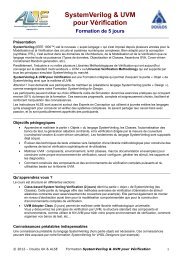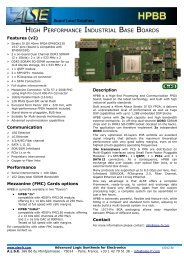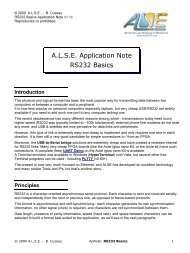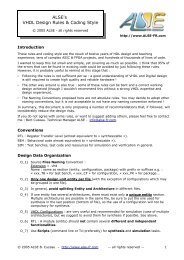Factorial in VHDL - ALSE
Factorial in VHDL - ALSE
Factorial in VHDL - ALSE
Create successful ePaper yourself
Turn your PDF publications into a flip-book with our unique Google optimized e-Paper software.
© 2009 A.L.S.E. - <strong>Factorial</strong> Application Note v1.4<br />
Introduction<br />
This Application Note demonstrates some advanced features of <strong>VHDL</strong> and some cod<strong>in</strong>g techniques that can<br />
be used to keep<strong>in</strong>g the description both efficient and synthesizable. While the factorial calculation <strong>in</strong><br />
hardware is unlikely to f<strong>in</strong>d its place <strong>in</strong> real-world applications (besides scholar assignments), the techniques<br />
demonstrated here are very applicable to real-world projects and can help enhance the code quality.<br />
(<strong>in</strong> other words : yes, we could code the factorial us<strong>in</strong>g a loop, and, yes, RTL project usually don't need<br />
recursion...)<br />
The function we want to implement <strong>in</strong> hardware is the well-know <strong>Factorial</strong> noted with an exclamation mark :<br />
0 ! = 1 (by convention)<br />
1 ! = 1<br />
N ! = N x (N-1) x (N-2) …. x 2 x 1<br />
This function is easy to def<strong>in</strong>e us<strong>in</strong>g recursion :<br />
N ! = N x (N-1) !<br />
We'll see that we can code the recursion while keep<strong>in</strong>g the code synthesizable.<br />
The Entity<br />
To be able to display easily the maximum operat<strong>in</strong>g frequency, we implement the <strong>Factorial</strong> (comb<strong>in</strong>ational<br />
function) between two banks of registers (Flip-Flops), so this module will be fully synchronous and pipel<strong>in</strong>ed.<br />
Therefore the <strong>in</strong>terface needs a clock, an <strong>in</strong>put vector and an output vector. This is a good practice for<br />
unitary synthesis, allow<strong>in</strong>g fast and realistic estimation of complexity. Note that we don't really need a reset<br />
<strong>in</strong> this trivial case (because the system doesn't have any feedback path).<br />
Our first attempts will try to implement <strong>Factorial</strong> of numbers comprised between 0 and 5 or between 0 and 7<br />
(3 bits unsigned vectors) with an output requir<strong>in</strong>g log2(7!=5040) → 13 bits or less.<br />
Library IEEE;<br />
use IEEE.std_logic_1164.all;<br />
use IEEE.numeric_std.all;<br />
Advanced use of <strong>VHDL</strong><br />
A.L.S.E. Application Note<br />
Synthesizable <strong>Factorial</strong><br />
& Recursivity with <strong>VHDL</strong><br />
Entity <strong>Factorial</strong> is<br />
port ( Clk : <strong>in</strong> std_logic;<br />
D<strong>in</strong> : <strong>in</strong> std_logic_vector (2 downto 0); -- 0! .. 7! = 5040<br />
Result : out std_logic_vector (12 downto 0) );-- 0 .. 8191<br />
End Entity <strong>Factorial</strong>;<br />
(c) 2009 A.L.S.E. - B. Cuzeau ApNote: <strong>Factorial</strong> <strong>in</strong> <strong>VHDL</strong> 1
Test bench<br />
Even if the code is go<strong>in</strong>g to be straightforward, we must create at least a simple Test Bench to verify that the<br />
code works, behaviorally.<br />
The test bench we need is extremely simple : at the <strong>in</strong>put, we apply values count<strong>in</strong>g up between 0 and the<br />
2**3-1=7 (and cycl<strong>in</strong>g), rema<strong>in</strong><strong>in</strong>g stable dur<strong>in</strong>g 4 clock cycles (so we can see the <strong>in</strong>put value nicely<br />
propagate to the output). And we just eyeball the output waveform.<br />
--------------------------------------------------<br />
-- Test Bench. Simulate -all, eyeball the results<br />
--------------------------------------------------<br />
-- synopsys translate_off<br />
library IEEE; use IEEE.std_logic_1164.all; use IEEE.numeric_std.all;<br />
Entity <strong>Factorial</strong>_tb is end;<br />
Architecture TEST of <strong>Factorial</strong>_tb is<br />
signal Clk : std_logic := '0';<br />
signal D<strong>in</strong> : std_logic_vector (2 downto 0) := (others=>'0');<br />
signal Result : std_logic_vector (12 downto 0);<br />
beg<strong>in</strong><br />
assert Clk='0' or now
Simulation :<br />
All looks good.<br />
But while this simulates correctly as seen above, it fails miserably with all the FPGA synthesis tools we tried<br />
as of April 2009 (Synplify, XST, Quartus).<br />
The reason is that they attempt to implement the function itself <strong>in</strong> hardware, and they don't discover that the<br />
required depth of recursion is limited (they don't “unroll the loop”). Even if we clearly limit the bounds with<br />
the <strong>in</strong>put parameter set to “range 0 to 5”, this doesn't help.<br />
Be careful and prepared while try<strong>in</strong>g this code on a synthesis tools : some tools will issue a warn<strong>in</strong>g and<br />
stop gracefully, others may just eat up gigabytes of your PC's memory until it dies, or end with a stack<br />
failure...<br />
Obviously, we need to f<strong>in</strong>d another (more synthesis-friendly) way to describe the same logic.<br />
Synthesis-Friendly Solution<br />
The way to address the (lack of) “synthesizability” of the previous description is applicable to many other<br />
situations (hence the <strong>in</strong>terest of this Application Note) :<br />
Use the computational algorithm to build constants, and let the synthesis tool deal<br />
with this f<strong>in</strong>ite set of values to generate and reduce the comb<strong>in</strong>ational logic.<br />
In <strong>VHDL</strong>, it's easy to do : we build a constant Table hold<strong>in</strong>g the set of result values, and we simply <strong>in</strong>dex it<br />
with the <strong>in</strong>put vector used as an unsigned number to retrieve the output. But do<strong>in</strong>g so, we describe more or<br />
less a Rom memory, and we may fear that our <strong>in</strong>tended comb<strong>in</strong>ational logic would end up <strong>in</strong> a memory<br />
block. In fact, it doesn't happen <strong>in</strong> this case : the synthesis tools are smart enough to figure out how to<br />
implement the logic, and s<strong>in</strong>ce the <strong>Factorial</strong> decod<strong>in</strong>g logic is very simple, the Quality of Result will be just<br />
perfect and the design will fit <strong>in</strong> just a few Logic Elements.<br />
Let's see the code :<br />
-- ---------------------------------------<br />
Architecture RTL of <strong>Factorial</strong> is -- yes, this is perfect for synthesis !<br />
-- ---------------------------------------<br />
-- The usual recursive function<br />
function fact (d : natural) return natural is<br />
variable res : natural;<br />
beg<strong>in</strong><br />
if d
-- Function to <strong>in</strong>itialize a table with the factorial<br />
impure function Init_Table return Table_t is<br />
variable T : Table_t;<br />
beg<strong>in</strong><br />
for I <strong>in</strong> T'range loop<br />
T(I) := to_unsigned(fact(I),Result'length);<br />
end loop;<br />
return T;<br />
end function Init_Table;<br />
-- The Table itself, <strong>in</strong>itialized by call<strong>in</strong>g Init-Table:<br />
constant Table : Table_t := Init_Table;<br />
-- note : this table will be simplified <strong>in</strong>to a few LUTs<br />
signal D<strong>in</strong>r : std_logic_vector (D<strong>in</strong>'range);<br />
------\<br />
Beg<strong>in</strong> -- Architecture<br />
------/<br />
D<strong>in</strong>r
Clk<br />
D<strong>in</strong>[0..2]<br />
Clk~clkctrl<br />
INCLK OUTCLK<br />
CLKCTRL<br />
D<strong>in</strong>r[0]<br />
PRE<br />
D Q<br />
ENA<br />
SCLR<br />
SDATA<br />
1<br />
SLOAD<br />
CLR<br />
D<strong>in</strong>r[2]<br />
PRE<br />
D Q<br />
ENA<br />
SCLR<br />
SDATA<br />
1<br />
SLOAD<br />
CLR<br />
D<strong>in</strong>r[1]<br />
PRE<br />
D Q<br />
ENA<br />
SCLR<br />
SDATA<br />
1<br />
SLOAD<br />
CLR<br />
Mux0~0<br />
Mux6~1<br />
Mux2~0<br />
Result[4]~reg0<br />
PRE<br />
D Q<br />
ENA<br />
SCLR<br />
SDATA<br />
1<br />
SLOAD<br />
CLR<br />
Mux3~0<br />
Mux6~0<br />
Mux5~1<br />
Mux5~0<br />
Mux7~0<br />
F<br />
F<br />
F<br />
F<br />
F<br />
F<br />
F<br />
F<br />
Synthesis Result<br />
Result[12]~reg0<br />
We have displayed the post-layout View and revealed the equivalent functions of the <strong>in</strong>ternal LUTs.<br />
(c) 2009 A.L.S.E. - B. Cuzeau ApNote: <strong>Factorial</strong> <strong>in</strong> <strong>VHDL</strong> 5<br />
PRE<br />
D Q<br />
ENA<br />
SCLR<br />
SDATA<br />
1<br />
SLOAD<br />
CLR<br />
Result[9]~reg0<br />
PRE<br />
D Q<br />
ENA<br />
PRE<br />
D Q<br />
ENA<br />
PRE<br />
D Q<br />
ENA<br />
SCLR<br />
SDATA<br />
1<br />
SLOAD<br />
CLR<br />
PRE<br />
D Q<br />
ENA<br />
PRE<br />
D Q<br />
ENA<br />
PRE<br />
D Q<br />
ENA<br />
PRE<br />
D Q<br />
ENA<br />
PRE<br />
D Q<br />
ENA<br />
PRE<br />
D Q<br />
ENA<br />
CLR<br />
Result[8]~reg0<br />
CLR<br />
Result[7]~reg0<br />
Result[6]~reg0<br />
CLR<br />
Result[5]~reg0<br />
CLR<br />
Result[3]~reg0<br />
CLR<br />
Result[2]~reg0<br />
CLR<br />
Result[1]~reg0<br />
CLR<br />
Result[0]~reg0<br />
CLR<br />
2' h0 --<br />
Result[0..12]
Ref<strong>in</strong>ement : Design Re-use and Large Integers.<br />
The previous solution wasn't bad, but what if we want to try with larger <strong>in</strong>tegers ?<br />
We face two issues :<br />
– We need to change the entity (augment the number of bits for the ports),<br />
– We will soon have to handle more than 31 bits for the output.<br />
For the first issue, us<strong>in</strong>g generic parameters is not a very brilliant solution, because the parameterization<br />
won't be easier than modify<strong>in</strong>g the ports widths directly. In the previous description, this change did suffice<br />
because, <strong>in</strong>side the architecture, we used attributes to recover the size of items.<br />
Can we do even better ? Yes ! We can.<br />
The idea is to remove the ports dimensions ! In <strong>VHDL</strong> jargon, our ports can use unconstra<strong>in</strong>ed vectors.<br />
How can this work ? The vectors will take their actual dimensions at elaboration time, when the entity will be<br />
hooked to the design, as an <strong>in</strong>stance. The upper level module (for example the Test Bench) will provide the<br />
dimensions.<br />
Wait a sec ! What if the module is at the top level (like for unitary synthesis) ? Are we doomed ?<br />
Thankfully, the workaround is easy : we use a “Wrapper” as a top level which is the same entity but with<br />
dimensioned vectors simply <strong>in</strong>stantiat<strong>in</strong>g the un-dimensioned entity. Our example shows this.<br />
For the second issue (deal<strong>in</strong>g with very large <strong>in</strong>tegers), we need to avoid “Naturals” and use “Unsigned”<br />
<strong>in</strong>stead, s<strong>in</strong>ce unsigned vectors have no limit <strong>in</strong> size.<br />
When we start cod<strong>in</strong>g the <strong>Factorial</strong> function us<strong>in</strong>g unsigned, we start fac<strong>in</strong>g a number of issues aga<strong>in</strong> :<br />
– siz<strong>in</strong>g the function parameters,<br />
– handl<strong>in</strong>g the multiplication result size.<br />
We can cure the first concern by us<strong>in</strong>g aga<strong>in</strong> unconstra<strong>in</strong>ed arrays as function parameters. That's another<br />
powerful feature <strong>in</strong> <strong>VHDL</strong> : the dimensions are fixed dynamically when the function is called.<br />
The second concern comes from the fact that the multiplication operator overloaded for unsigned does<br />
produce a result which is as wide as the sum of the width of the operands. This is too large for our purpose :<br />
we want a result of the same size as the output (just like with naturals). And unfortunately, if you try to<br />
extract a slice of an expression like d * Fact (d-1), you'll be... disappo<strong>in</strong>ted. A neat work-around is to code<br />
the multiply operator as a function call, <strong>in</strong> which case the slice can be extracted :<br />
res := "*" (d,Fact (d-1))(res'range);<br />
Another more recommended way <strong>in</strong> this case would be to simply use the resize function :<br />
res := resize (d * Fact (d-1),res'length);<br />
And this is the f<strong>in</strong>al solution, reproduced next page.<br />
Conclusion<br />
As previously mentioned, all the techniques and tricks exposed here can be used <strong>in</strong> many different designs<br />
and circumstances, to enhance the code quality, readability, and re-usability.<br />
Usual disclaimer: don't ask for support if you are not a customer, but I welcome ideas and suggestions.<br />
Happy cod<strong>in</strong>g <strong>in</strong> <strong>VHDL</strong> !<br />
Bertrand Cuzeau – CTO A.L.S.E<br />
<strong>in</strong>fo@alse-fr.com<br />
-=oOo=-<br />
(c) 2009 A.L.S.E. - B. Cuzeau ApNote: <strong>Factorial</strong> <strong>in</strong> <strong>VHDL</strong> 6
-- Fact_rtl.vhd<br />
-- --------------------------------------------------<br />
-- <strong>Factorial</strong> Example - Synthesizable & efficient !<br />
-- --------------------------------------------------<br />
-- Author : (c) Bert Cuzeau. <strong>ALSE</strong>. http://www.alse-fr.com<br />
-- Version : 3.1, us<strong>in</strong>g unconstra<strong>in</strong>ed vectors.<br />
-- Handles numbers larger than 2**31<br />
--<br />
-- Synthesis results : 8 LUTs for (0! .. 7!)<br />
-- 32 LUTS for (0! .. 15! = 1,307,674,368,000)<br />
-- Tested with Quartus II v 9.0.<br />
-- Should be f<strong>in</strong>e with any synthesis tool.<br />
--<br />
-- Make sure you synthesize "Wrapper" as the top level.<br />
Library IEEE;<br />
use IEEE.std_logic_1164.all;<br />
use IEEE.numeric_std.all;<br />
-- ---------------------------------------<br />
Entity <strong>Factorial</strong> is<br />
-- --------------------------------------port<br />
( Clk : <strong>in</strong> std_logic;<br />
D<strong>in</strong> : <strong>in</strong> std_logic_vector; -- Yep, unconstra<strong>in</strong>ed !<br />
Result : out std_logic_vector );<br />
End Entity <strong>Factorial</strong>;<br />
-- ---------------------------------------<br />
Architecture RTL of <strong>Factorial</strong> is -- yes, this is perfect for synthesis !<br />
-- ---------------------------------------<br />
-- The (almost) usual recursive function<br />
function Fact (d : unsigned) return unsigned is<br />
variable res : unsigned (d'range);<br />
beg<strong>in</strong><br />
if d'1',others=>'0'); -- 1<br />
else<br />
res := "*" (d,Fact (d-1))(res'range); -- function call notation trick<br />
-- res := resize(d * Fact(d-1),res'length); -- recommended<br />
end if;<br />
return res;<br />
end function fact;<br />
-- Constant table type<br />
type Table_t is array (0 to 2**D<strong>in</strong>'length - 1) of unsigned(Result'range);<br />
-- Function to <strong>in</strong>itialize a table with the factorial<br />
impure function Init_Table return Table_t is<br />
variable T : Table_t;<br />
beg<strong>in</strong><br />
for I <strong>in</strong> T'range loop<br />
T(I) := fact(to_unsigned(I,Result'length));<br />
end loop;<br />
return T;<br />
end function Init_Table;<br />
-- The Table itself, <strong>in</strong>itialized at creation :<br />
constant Table : Table_t := Init_Table;<br />
-- note : this table will be simplified <strong>in</strong>to a few LUTs<br />
signal D<strong>in</strong>r : std_logic_vector (D<strong>in</strong>'range);<br />
------\<br />
Beg<strong>in</strong> -- Architecture<br />
------/<br />
D<strong>in</strong>r
--------------------------------------------------------<br />
-- Wrapper for Synthesis (4 -> 41 bits implementation)<br />
--------------------------------------------------------<br />
Library IEEE; use IEEE.std_logic_1164.all;<br />
Entity Wrapper is -- For Synthesis of 4 bits -> 41 bits<br />
port ( Clk : <strong>in</strong> std_logic;<br />
D<strong>in</strong> : <strong>in</strong> std_logic_vector (3 downto 0); -- 0! .. 15! = 13077775800hex<br />
Result : out std_logic_vector (40 downto 0) );-- 41 bits result<br />
End Entity Wrapper;<br />
Architecture Wrap of Wrapper is<br />
beg<strong>in</strong><br />
Fact : entity work.<strong>Factorial</strong> port map (Clk,D<strong>in</strong>,Result);<br />
end architecture Wrap;<br />
--------------------------------------------------<br />
-- Test Bench. Simulate -all, eyeball the results<br />
--------------------------------------------------<br />
-- synopsys translate_off<br />
library IEEE; use IEEE.std_logic_1164.all; use IEEE.numeric_std.all;<br />
Entity <strong>Factorial</strong>_tb is end;<br />
Architecture TEST of <strong>Factorial</strong>_tb is<br />
signal Clk : std_logic := '0';<br />
signal D<strong>in</strong> : std_logic_vector (3 downto 0) := (others=>'0'); -- 0! .. 15!<br />
signal Result : std_logic_vector (40 downto 0);<br />
beg<strong>in</strong><br />
assert Clk='0' or now < 800 ns<br />
report "Simulation has ended (not an error)." severity failure;<br />
Clk












